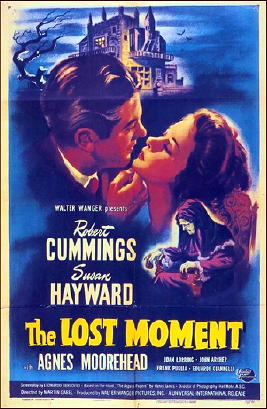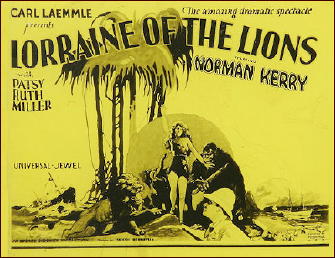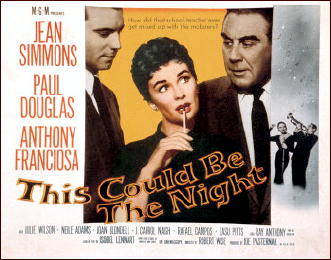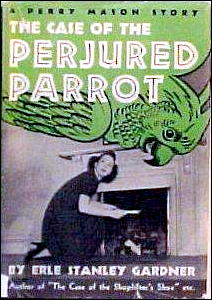September 2010
Monthly Archive
Tue 21 Sep 2010
Posted by Steve under
Reviews[9] Comments
THE ARMCHAIR REVIEWER
Allen J. Hubin
ROBERT BARNARD – At Death’s Door. Scribner’s, US, hardcover, 1988. Paperback reprint: Dell, 1989. British edition: Collins Crime Club, hardcover, 1988.
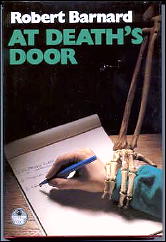
I do think Robert Barnard goes from strength to strength, though I’m not sure how he does it with his prolificity: At Death’s Door was his second novel published here this past year [1988].
His character probings are becoming more subtle, but his people, full of all their weaknesses and strengths, their humanities, leap off the pages in sharpest individuality.
In this one they are the family, legitimate and otherwise, of Benedict Cotterel, famous writer and rake, now octogenarian and senile. His daughter Cordelia, produced by the now renowned actress and once mistress Myra Mason, has decided to write a book about her mother — whom she loathes– and Ben.
She comes to the home of Roderick and Cordelia Cotterel — Roderick being one of two offsrping by an early Cotterel marriage — where Benedict is vegetating. Myra, hearing of the book project, comes furiously to the little British village with her latest bedmate in tow, determined to stop Cordelia in her tracks.
Into this comes murder, and Inspector Meredith (whom I’ve a notion Barnard has served us before) does some fancy footwork to identify the guilty. Barnard’s plotting is elegant as well, and he has yet one more surprise at the end for us.
Magnificent!
— From The MYSTERY FANcier, Vol. 11, No. 2, Spring 1989.
Bibliographic Note: Inspector Idwal Meredith did indeed appear in another Barnard mystery: Unruly Son (Collins, 1978; US title: Death of a Mystery Writer. Scribner, 1979).
Tue 21 Sep 2010
REVIEWED BY GEOFF BRADLEY:
MISSING. BBC-TV. Second series: 15 March through 26 March 2010. Pauline Quirke, Felix Scott, Pooja Shah, Mark Wingett.
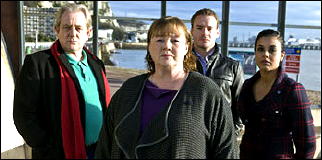
This is an afternoon programme returning for a second series of ten 45-minute programmes (no adverts). Pauline Quirke plays Detective Sergeant Croft who is in charge of a missing persons unit in Dover.
She has in her squad a detective constable and a female assistant. Together they chase up all reports of missing persons occasionally using a local radio reporter to broadcast appeals. This series is complicated by a new aggressive Chief Inspector who casts a shadow over the team.
This is very comfortable day-time viewing with no disastrous outcomes for the missing people. A happyish ending is usually in sight. However, twee as it is, I rather enjoyed this second series as I did the first last year.
Tue 21 Sep 2010
Posted by Steve under
ReviewsNo Comments
IT IS PURELY MY OPINION
Reviews by L. J. Roberts
EDWARD MARSTON – The Merry Devils. St. Martin’s Press, US, hardcover, 1990. Paperback reprint: Fawcett Crest, 1991. Trade paperback: Poisoned Pen Press, 2001. UK edition: Bantam, hardcover 1989.
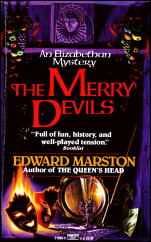
Genre: Historical mystery. Leading character: Nicholas Bracewell; 2nd in series. Setting: England-Elizabethan period.
First Sentence: London was the capital city of noise, a vibrant, volatile place, surging with life and clamorous with purpose.
Lord Westfield’s Men, an Elizabethan acting company, is presenting a new play, “The Merry Devils.” Contrary to the stage direction of book-holder, Nicholas Bracewell, a third “devil” appears when the scene only calls for two.
Upon the second presentation, Bracewell decides to have there be three devils, but only two appear. The third is found dead under the stage. Threats increase and Nicholas must find who is behind it before anyone else dies.
Marston is one of the best at crafting time and place. He takes us from the workings of the theater, to the streets, to the properties of nobles to Bethlehem Hospital, otherwise known as Bedlam. This was a time when Christianity and superstition were intertwined and strict Puritanism was on the rise.
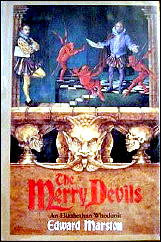
The cadence and syntax of the dialogue reflect the period while delightful metaphors and humor exemplify the characters. The cast of characters is interesting and appealing. Marston has provided enough of Bracewell’s background to bring him to life but has, intentionally to us and the other characters, left much in the shade.
The members of the company reflect the egos, insecurities and conflicts one would expect without be stereotypes. All the characters have dimension and substance. I did appreciate the character of Dr. John Mordrake, based on Dr. John Dee, mathematician, scientist, occultist and consultant to Queen Elizabeth I. He seems to be the subject of numerous books these days.
Although there was a very good, twisty plot and a dramatic ending, it did feel overly contrived. However, that did not diminish my enjoyment or my anticipation of Marston’s next Elizabethan Theater book.
Rating: Good Plus.
Previously reviewed by LJ:
The Owls of Gloucester (The “Domesday” series)
The Queen’s Head (Nicholas Bracewell, 1st in series)
Mon 20 Sep 2010
REVIEWED BY DAN STUMPF:
HENRY JAMES – The Aspern Papers. Macmillan, hardcover, US/UK, 1888. First published in three parts in The Atlantic Monthly, March-May 1888. Reprinted many times since.
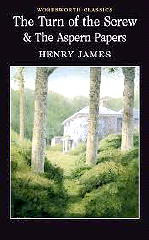
Filmed as The Lost Moment: Universal Pictures, 1947. Robert Cummings, Susan Hayward, Agnes Moorehead, Joan Lorring, Eduardo Ciannelli, John Archer. Screenplay: Leonardo Bercovici. Director: Martin Gabel.
Well I got around to Henry James again and landed on his 1888 novella The Aspern Papers, probably his most accessible work except for Turn of the Screw. Which ain’t saying a whole hell of a lot, because James never uses one word where he can put twenty, and his notion of objectivity is to invariably leave his characters disappointed.
Yet there is, withal, an easy grace in his prolix prose and a muted yearning in his plots that keeps me coming back. James’ characters long for the heroism their author denies them, a theme that doesn’t appear this consistently again in American Lit until David Goodis, and maybe it’s this that keeps drawing me back.
Whatever the case, Aspern, as I say is a bit more engaging than most James, with something like a real plot, about a publisher/literary enthusiast looking for material relating to a romantic poet who died in the last century.
It seems that a young woman with whom the poet had an affair still lives, incredibly old now, in a decaying mansion in Venice with her niece, and she may have love letters from her legendary paramour. In short order the poetry sleuth inveigles himself into the house, only to find he has entered their lives as well.
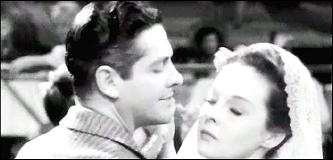
It’s a fine, romantic premise for a book, and James handles it competently, with a realism in his characters that threatens at times to bleach all the excitement from the idea, but manages to keep it alive somewhere just under the surface of his inhibitions. The conclusion is typical of James as well: disappointing and yet somehow satisfying in its context.
Universal studios, home of Abbott and Costello and the Wolfman, brought this to the screen in 1947. Or at least they brought the premise; James’ placid plot and wan protagonists are replaced in The Lost Moment by a noirish romanticism the author would hardly have recognized.
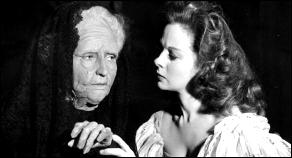
The pusillanimous publisher is portrayed by an earnest Bob Cummings, and the reticent niece by sultry Susan Hayward, who seethes with pent-up passion even at her most spinsterish. A kindly dowager who sets the plot in motion on the first page becomes a venal painter with plans of his own (played by John Archer in a Melvyn Douglasmode) and the aged muse/lover of the dead poet is portrayed by a rasping Agnes Moorehead — at least they say it’s Agnes Moorehead; under all those veils and wrinkled makeup it could be Lon Chaney Jr for all I know.
All this could easily have led to a massive betrayal of James’ novel, but it’s saved by a literate script by Leonardo Bercovici (a subsequently-blacklisted author who worked on off-beat romances like Portrait of Jennie and The Bishop’s Wife) and lush, romantic direction by Martin Gabel, of all people.
Gabel always played it cold and constipated in the movies, and his work here as a smooth, moody auteur in the style of Max Ophuls is one of those minor miracles with which the cinema is occasionally blessed.
Mon 20 Sep 2010
Back in January of 2009, I posted an article by Nicholas Flower about his role in creating new titles for Charles Williams’ crime novels when they were published in the UK by Cassell.
The piece was updated in February, and in March cover images of five more dust jackets of books in the Cassell series were added, thanks to Bill Pronzini, along with new commentary about them by Nicholas.
Cassell published fifteen Charles Williams thrillers, though, and until last week there were only twelve that were included in Nicholas’ article. And there things stood, until now, thanks to some helpful online booksellers who very kindly supplied us with images of the three that were missing. All fifteen covers are now part of that original post.
I hope you’ll go back and take a look. You can find the post here. I think it’s worth the visit, or even a revisit!
— Steve
Sun 19 Sep 2010
The 2010 NYC Vintage Paperback and Collectable Book Expo
by WALKER MARTIN
Just back from attending this long running one day event that Gary Lovisi has managed to organize for over 20 years on an annual basis. Over 50 sellers in a large dealers’ room selling vintage paperbacks, pulps, new books, and original artwork. Prices seemed very reasonable to me and I managed to find several of my Dime Mystery pulp wants.
Steve and I had discussed the problems in attending this show because we both were limping around due to overexertion. Steve couldn’t make it, but I manage to survive the train ride from Trenton, NJ to NYC with the help of long time collector Digges La Touche.
We arrived at the show at a little after 9:00 am Sunday and were immediately met with the delicious aroma of old books and pulp paper. The crowd appeared even bigger than last year and consisted mainly of elderly book collectors of the male gender. There were a few females trying to reign in their husbands and boyfriends passionate love of collecting but it was a losing battle.
You know what I’m referring to: the age-old battle between the non-collector and the collector. These battles have led to the breakup of many a marriage, and many a collection has been ordered sold by the courts in order to split the proceeds. A collector’s worst nightmare!
There were numerous guests selling and signing their books. Too many to mention but I do want to give special note to someone I consider the most notable writer present: Ron Goulart. Not only has he been a professional writer for over 40 years but he has written some excellent books on the pulps such as Cheap Thrills, The Dime Detectives, The Hardboiled Dicks and others. C. J. Henderson had a table selling his numerous books and driving collectors nuts by yelling at them to come and visit “The Wonderful of Me”. This of course just scares everyone away.
As we all know, a great part of the fun of collecting involves the many friends that we make over the years. Here are some notes about the collectors I talked to at the show:
Tom Lesser. One of the great West Coast paperback collectors who organizes the annual LA Paperback Convention each year. He just had a bypass operation, and I’m happy to report he is up and about and looking better than ever.
Dan Roberts. Another serious paperback and art collector who has one of the largest collections in the world.
Paul Herman. Pulp and art collector who always has interesting items at his table.
Ed Hulse. Publishing and editor of Blood n Thunder magazine which deals with the pulp and movie world.
Nick Certo. A major pulp, paperback and art dealer.
Mark Halegua. Organizer of the Gotham Pulp meeting every month in NYC.
David Saunders. Artist and author of many articles in Illustration Magazine. He is the author of the excellent book on Norman Saunders and the new book on Ward, the pulp artist.
Rich Harvey. Organizer of the annual Pulp Adventure Con in Bordentown, NJ.
Chris Eckhoff. Dealer and expert in the field of paperback erotic novels.
The above are just a sample of the crazed and over the top dealers and collectors that you can meet at this convention. The paperback collecting field is wide open, and most paperbacks are very inexpensive. This show and the LA show should not be missed, especially if you live within two or three hours driving distance. Collecting books has been called the grandest game in the world and this show proves it.
Sat 18 Sep 2010
REVIEWED BY WALTER ALBERT:
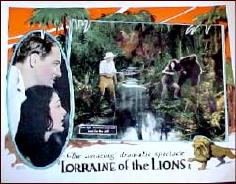
LORRAINE OF THE LIONS. Universal, 1925. Norman Kerry, Patsy Ruth Miller, Fred Humes, Doreen Turner, Harry Todd, Philo McCullugh, Joseph J. Dowling.
Scenario by Isadore Bernstein & Carl Krusada; screenplay by Isadore Bernstein. Director: Carl Krusada. Shown at Cinevent 42, Columbus OH, May 2010.
Herewith a feminist Tarzan ripoff that I wouldn’t have missed for anything other than a screening of the sole surviving print of London After Midnight.
After a storm demolishes the ship bringing Lorraine (Patsy Ruth Miller), her parents, and their jungle circus back from an Australian tour, Lorraine is washed up on a desert island, where she is raised by one of the surviving animals, a gorilla named “Bimi” (played by Fred Humes).
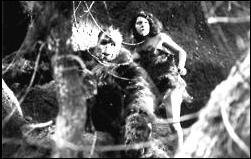
Years later, her wealthy grandfather; who’s been searching for survivors, enlists the aid of an itinerant psychic (Norman Kerry) who leads a rescue party to the island, returning the initially reluctant Lorraine, along with Bimi, to civilization, represented by her grandfather’s palatial San Francisco mansion.
The print was excellent, and even though I kept telling myself that this was pure, unadulterated schlock, the kid in me didn’t believe a word of it.
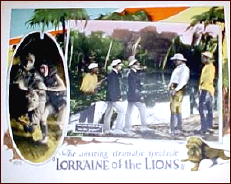
I would give this an unconditional recommendation for the junior set if it were not for an unfortunate plot turn that involved Bimi and cast a pall over the traditional happy ending.
Would Tarzan have treated Kala the way Lorraine treated Bimi? I think not.
I was also bothered by the fact that Kerry and the lead villain both sported the same pencil-thin moustache, were slender in build, and tended to wear what appeared to be the same grey suit.
Well, what do you expect of a film in which the only real emotional resonance comes from a man in a gorilla suit?
Sat 18 Sep 2010
GEORGES SIMENON IN THE NEWS
by Tise Vahimagi
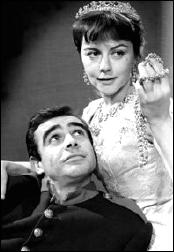
In mid-September 2010 the Library of Congress proudly announced that not only had it (the Library’s Moving Image Section) discovered some 68 rare British TV recordings in the Library’s National Educational Television (NET) Collection but they were handing over digital copies of this treasure trove representing Britain’s “golden age of television” to a very grateful British Film Institute (BFI).
These treasures include such rare finds as Sean Connery and Dorothy Tutin in Jean Anouilh’s Colombe (BBC, 1960), the Zeffirelli-directed (stage) Much Ado About Nothing (BBC, 1967) and director-producer Rudolph Cartier’s Rembrandt (BBC, 1969).
Perhaps for the crime and mystery buff, one of these treasures is (I am delighted to say) the 1966 BBC series Thirteen Against Fate, long considered “missing, believed wiped.” Now, along with the few surviving episodes held by the BFI, the discovery of the rest of the series (ten additional episodes from the Library of Congress) makes this, finally, a “complete” series. Soon, hopefully, all will be available for viewing; and, perhaps, one day, they’ll be out on DVD!
The following quotes are from the the British editions of the daily newspapers:
â— The series’ producer Irene Shubik said, at the time: “These plays are not for the squeamish. They are not light detective stories, but intense psychological studies of individuals deeply involved in the aftermath of murder or death.” (
The Sun, 13 July 1967).
â— “At the its best the series has given an insight into the criminal mind and brought a welcome relief from the cliché of the effortless, infallible and more or less immaculate detective.” (Daily Telegraph, 8 August 1966).
â— “The new Simenon series made an excellent start on Sunday. It is unlikely to be as popular as its predecessor [Maigret, BBC 1960-63)] for it lacks a reiterative figure like Maigret to give it a common stamp.
“Simenon is a master of naturalism, and absolute accuracy of detail and careful selection of that detail are essential for transposing him.” (Financial Times, 22 June 1966).
â— “An intelligent television crime series that concentrates on the character of the criminal instead of the almost invariably successful process of detection is overdue.” (Daily Telegraph, 20 June 1966).
â— “With Irene Shubik as producer the plays are so thoroughly and carefully set in their time and place that the atmosphere generated becomes a powerful element in their appeal.” (The Guardian, 27 June 1966)
This seems like an appropriate opportunity to present an episode guide for your perusal:
A BBC production. Produced by Irene Shubik. Transmitted via BBC1: June to September 1966. Based on 13 non-Maigret stories by Georges Simenon.
1. The Lodger (transmitted 19 June)
Script: Hugh Leonard. Director: James Ferman.
Cast: Zia Mohyeddin, Gwendolyn Watts, Gemma Jones.
Based on Simenon story “Le Locataire” (1934).
â— “The first of the new series was strong on all these points [previous
Financial Times quote]. Hugh Leonard didn’t compromise with the tale itself, a grimy little murder committed out greed and lust.” (
Financial Times, 22 July 1966).
â— “‘The Lodger’ was the first of 13 Simenon stories adapted for television, and it contained, surprisingly, not a whiff of Maigret, garlic or pipe-smoke. It was about the agony of a murderer on the run, and the terror of a simple Belgian family at discovering their paying guest is a killer.
“It kept its promise of being unsuitable for the squeamish, and, although the end was inevitable, it was a tense and moving experience.” (The Sun, 20 June 1966).
â— “The series made a telling, if high-pitched, start, dramatised by the admirable Hugh Leonard. The police get their man, but this is incidental, and the play chiefly shows what can be explored once the Maigrets and Barlows [the latter in reference to a popular Police Detective character played by Stratford Johns in the UK police series Softly, Softly (1966-69)] of this world are moved to one side.” (Daily Telegraph, 20 June 1966).
â— “Everybody concerned made a powerful affair of ‘The Lodger,’ the first of 13 novels by Georges Simenon to be shown on BBC1.” (The Times, 20 June 1966).
2. Trapped (26 June)
Scr: Julia Jones. Dir: George Spenton-Foster.
Cast: Ronald Lewis, Keith Buckley, Sylvia Coleridge.
Based on “Cours d’Assises” (1941).
â— “The second of a series of plays is a better test than the first; though the first impact is over, familiarity has not had time to set in. In the second of the Simenon plays on BBC1 last night the quality of the production was more firmly established than in the first, and on this showing they are going to be very good. Simenon’s stories in this series are about criminals rather than detection.” (
The Guardian, 27 June 1966).
â— “Those who turned to BBC1 last night hoping that the second of the new Simenon series woul provide them with a nice, cosy murder mystery, must have had an uncomfortable time.
“Simenon, of course, is concerned with crime, not with setting puzzles for his readers, and crime is on the whole a depressingly sordid business. Because character is destiny, a young petty criminal finds himself sentenced for a murder he has not committed.” (The Times, 27 June 1966).
3. The Traveller (3 July)
Scr: Stanley Miller. Dir: Herbert Wise.
Cast: Kenneth J. Warren, Hywel Bennett, André van Gyseghem.
Based on “Le Voyageur de la Toussaint” (1941).
4. The Widower (10 July)
Scr: Clive Exton. Dir: Silvio Narizzano.
Cast: Joss Ackland, Henry Gilbert, Patricia Healey.
Based on “Le Veuf” (1959).
5. The Judge (17 July)
Scr: Hugh Leonard. Dir: Naomi Capon.
Cast: Alexander Knox, John Ronane, Peter Howell.
Based on “Les Témoins” (1955).
6. The Schoolmaster (24 July)
Scr: Alun Richards. Dir: Peter Potter.
Cast: Stephen Murray, Helen Cherry, Cyril Shaps.
Based on “L’Evadé” (1936).
7. The Witness (31 July)
Scr: John Hale. Dir: John Gorrie.
Cast: Pamela Brown, Daphne Heard, Moultrie Kelsall.
Based on “Le Haut Mal” (1933).
8. The Friends (7 August)
Scr: Anthony Steven. Dir: Michael Hayes.
Cast: Jessica Dunning, Frederick Jaeger, Sandor Elès.
Based on “Chemin sans issue” (1938).
9. The Survivors (14 August)
Scr: Stanley Miller. Dir: Rudolph Cartier.
Cast: Lila Kedrova, David Buck, Kathleen Breck, Terence de Marney.
Based on “Les Rescapés du Télémaque” (1938).
10. The Son (21 August)
Scr: Jeremy Paul. Dir: Waris Hussein.
Cast: Joan Miller, Simon Ward, Jack Woolgar, Clive Dunn, [way down the cast list] Lila Kaye.
Based on “Les Destins des Malous” (1947).
11. The Murderer (28 August)
Scr: Clive Exton. Dir: Alan Bridges
Cast: Frank Finlay, Michael Goodliffe, Annette Crosbie, Lyndon Brook.
Based on “L’Assassin” (1937).
â— “The original story was particularly interesting, concentrating as it did upon the mind and motive of a murderer who was never finally charged, and [Clive] Exton built a powerful play upon it.
“It was set in a respectable little Dutch town where Dr. Kuperus shot his wife and her lover and the story follows his gradual disintegration as he becomes the object of suspicion.” (
The Guardian, 29 August 1966).
12. The Suspect (4 September)
Scr: Donal Giltinan. Dir: Michael Hayes.
Cast: Marius Goring, Mary Miller, Peter Halliday.
Based on “Les Fiançailles de M. Hire” (1933).
â— “Goring conveyed movingly the confusion and uncertainty of a man with some petty vices trying to cope with the police and the treacherous advances of a girl who is shielding the real killer.” (
The Sun, 5 September 1966).
13. The Consul (11 September)
Scr: Leo Lehman. Dir: John Gorrie.
Cast: Jonathan Burn, Michele Dotrice, Jeannette Sterke.
Based on “Les Gens d’en Face” (1933).
Editorial Comment: A complete listing of this recently uncovered cache of vintage BBC programs can be found here. (Scroll down.)
Sat 18 Sep 2010

THIS COULD BE THE NIGHT. MGM, 1957. Jean Simmons, Paul Douglas, Anthony Franciosa, Julie Wilson, Neile Adams, Joan Blondell, Ray Anthony & His Orchestra. Screenplay: Isobel Lennart; based on short stories by Cornelia Baird Gross. Director: Robert Wise.
Why, one wonders, did they film this charming comedy/musical in CinemaScope but shoot it in black and white? Anytime I can see Jean Simmons in color, I’d jump at the chance, but that’s me. And black and white, too, if that’s the only chance I get.
I may be wrong about this, but I recall reading somewhere that This Could Be the Night was the last MGM musical to be filmed in black and white, and if so, it’s one fact it should be noted for. Another such fact, and this one I’m sure of, is that the movie marks the film debut of Tony Franciosa, a handsome as well as talented actor (in my opinion) whose charm seemed to show up more on TV than it did on the large screen – not that he became a huge star there, either.
He plays the co-owner of a New York City nightclub where Jean Simmons, a schoolteacher in the day, comes to work as a secretary at night. The other owner, the older one, is Paul Douglas, a gruff sort of guy who may have been a gangster in his day, takes a shine to her, while in the case of Tony Armatti (Franciosa), it’s dislike at first sight.
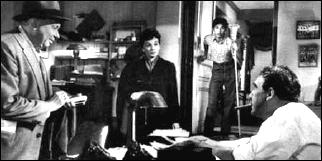
In the case of Anne Leeds (that’s Jean Simmons), nicknamed Baby almost immediately by the all of the dancers and staff as well as the two owners, it is a case of why should a recent graduate from Smith College (I hope I remember that correctly) find life in a nightclub so exciting? She is a virgin, as everyone wonders right off, although the word is never used (greenhorn, anyone? “nice girl”?) but no one (naturally) dares ask until the curvaceous singer Ivy Corlane (Julie Wilson’s character) does.
She reports back: “No hits, no runs, no errors.â€
And of course Baby takes over the place, teaching the striptease dancer how to win a cooking contest and win a new stove, for example, and helping a busboy pass an algebra test so his father will allow him to change his name.
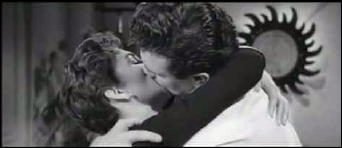
You also realize that in movies like this, what dislike at first sight eventually turns into, which of course complicates things. (Follow the link to a short but critical clip found on YouTube.)
Misunderstandings ensue, Baby quits her job, and it’s all great fun. The ending is wrapped up all too quickly, but otherwise I found this admittedly shallow if not completely tall tale of a film rather charming, as I said in my opening remarks, and I shall repeat the word now.
Even if as a former math teacher I have to point out that it’s cheating to have someone else do your algebra problems for you.
Fri 17 Sep 2010
Reviewed by MIKE GROST:

ERLE STANLEY GARDNER – The Case of the Perjured Parrot. William Morrow & Co., hardcover, 1939. Pocket #378; 1st printing, August 1947. Reprinted many times, in both hardcover and soft.
Gardner wrote a series of Western short tales set in desert locales for Argosy magazine (1930-1934). Some of these were collected in Whispering Sands (1981). “Law of the Rope” (1933) and “Carved in Sand” (1933) mix mystery puzzle plot elements, with the sleuth’s reconstruction of events during a crime by tracking trails left in the desert. This sort of reading of physical trails and evidence at a crime scene goes back to Gaboriau in mystery fiction.
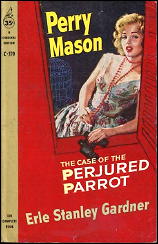
The Case of the Perjured Parrot (1939) is a Perry Mason tale, set not in the desert, but in a mountain forest. But it has another hermit-like nature-lover, like several of the desert tales, and an emphasis on reading clues from a murder scene to reconstruct a crime.
These clues are indoors at a fishing cabin, not outside, however, making a further difference from the desert tales. Some of this detection is done not by Perry Mason, but by a country sheriff whose good at “reading trail.”
The long opening (Chapters 1-5) tells a pleasantly elaborate tale, with a great flow of story and several nice twists and turns. Gardner is especially good at spinning out plot.
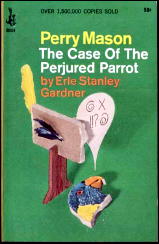
The solution (Chapters 12-14) is none too surprising, and the novel does not excel therefore as a puzzle plot mystery. Still, the solution’s twists are decent, and continue both the deductions from crime scene clues and the book’s pleasing flood of story.
The Case of the Perjured Parrot consists of one long murder investigation, of a single murder. It is more unified than many Gardner books. There is no preliminary mystery subplot in the opening chapters either: Perry Mason starts investigating the murder in the first chapter. Perry works less to defend a single client in this tale, and more purely as a detective, as well.
The Case of the Perjured Parrot, like the desert-set The Case of the Drowsy Mosquito, has a bit of high technology in it. Gardner perhaps had some artistic association between nature settings and technology, in his story-creation process.
Recommended.
« Previous Page — Next Page »







